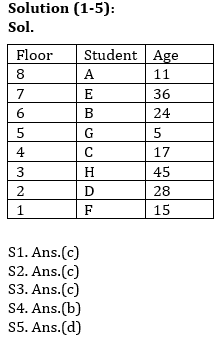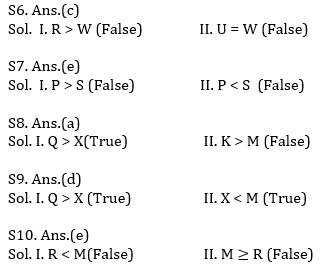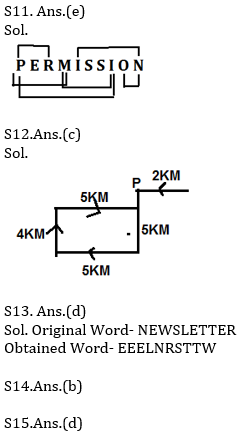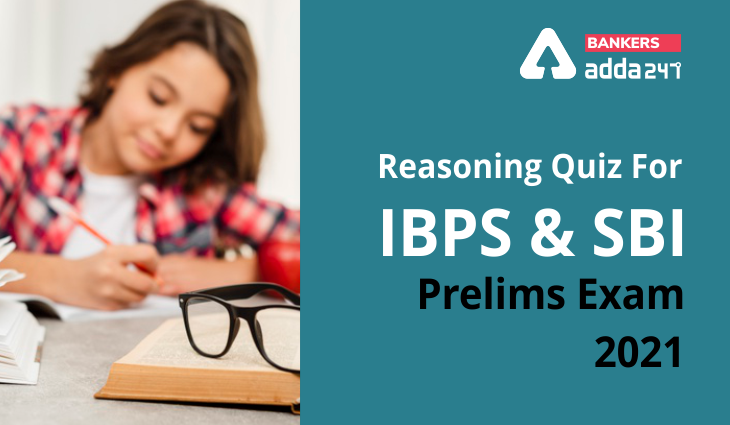Table of Contents
Directions (1-5): Read all the information carefully and answer the given questions:
There are eight people A, B, C, D, E, F, G and H they live on 8 different floors of a building, lowermost floor is numbered as 1 and topmost floor is numbered as 8. All are of different ages i.e. 45, 36, 28, 24, 5, 15, 17 and 11, but not necessarily in the same order.
There are two people live between E and C. H is the oldest person but doesn’t live on even numbered floor. There are only two people live between C and the floor on which third youngest person live. B lives just above the floor on which the person lives who is 5yrs old. E’s age is a perfect square of even number. B lives on an even numbered floor. E lives on odd numbered floor. Neither G nor F lives on 7th floor. B’s age is not 11 and 17 yrs. The one who lives on 2nd floor, his age is an even number, but he is not 24yrs old. A lives on even numbered floor above B. D lives on even numbered floor. Only two persons live between G and A, whose age is a prime number, but he is younger than F.
Q1. Who among the following lives on 5th floor?
(a) F
(b) C
(c) G
(d) A
(e) D
Q2. Who among the following is 28 yrs old?
(a) C
(b) A
(c) D
(d) B
(e) E
Q3. C lives on which of the following floor?
(a) 8th floor
(b) 3rd floor
(c) 4th floor
(d) 7th floor
(e) 1st floor
Q4. Who among the following is 17yrs old?
(a) F
(b) C
(c) A
(d) B
(e) D
Q5. How many persons lives between A’s floor and H’s floor?
(a) Two
(b) One
(c) Three
(d) Four
(e) None of these
Directions (6-10): In this question, relationship between different elements is shown in the statements. The statements are followed by conclusions. Study the conclusions based on the given statement and select the appropriate answer.
Q6. Statements: P>Q>R=U, U≥T<S, T≥W
Conclusions:
I. R>W
II. U=W
(a) Only conclusion I is true
(b) Only conclusion II is true
(c) Either conclusion I or II is true
(d) Both conclusions I and II are true
(e) Neither conclusion I nor II is true
Q7. Statements: P>Q>R<U, U≥V>S, V<W
Conclusions:
I. P>S
II. P < S
(a) Only conclusion I is true
(b) Only conclusion II is true
(c) Either conclusion I or II is true
(d) Both conclusions I and II are true
(e) Neither conclusion I nor II is true
Q8. Statements: A = K > X < L > N ≤ R; Q ≥ A; N = M
Conclusions:
I. Q > X
II. K > M
(a) Only conclusion I is true
(b) Only conclusion II is true
(c) Either conclusion I or II is true
(d) Both conclusions I and II are true
(e) Neither conclusion I nor II is true
Q9. Statements: J = K > X < L > N ≤ R; Q ≥ K; J < M
Conclusions:
I. Q > X
II. X < M
(a) Only conclusion I is true
(b) Only conclusion II is true
(c) Either conclusion I or II is true
(d) Both conclusions I and II are true
(e) Neither conclusion I nor II is true
Q10. Statements: J >K > X < L > N ≤ R; Q ≥ J < M
Conclusions:
I. R < M
II. M ≥ R
(a) Only conclusion I is true
(b) Only conclusion II is true
(c) Either conclusion I or II is true
(d) Both conclusions I and II are true
(e) Neither conclusion I nor II is true
Q11. How many pairs of letters are there in the word “PERMISSION” each of which have as many letters between them in the word as they have between them in the English alphabetical series?
(a) Two
(b) Five
(c) Three
(d) Four
(e) More than five
Q12. Meena faces west and walks 2 km to reach P, then turn left walks 5km. After this, she turns right and walks 5 km again. Now, she turns again towards right and walks 4km, then turn right and walks 5km. Now what is the shortest distance between Point P and Final position and in which direction she is with respect to P?
(a) 1km, North
(b) 2km, North east
(c) 1km, South
(d) 2km, South west
(e) None of these
Q13. The position of how many alphabets will remain unchanged if each of the alphabets in the word ‘NEWSLETTER’ is arranged in alphabetical order from left to right?
(a) Four
(b) One
(c) Three
(d) Two
(e) None
Q14. If the expressions ‘M>N ≤ O < P’, ‘N >Y’ and ‘P <Q’ are true, which of the following conclusions will be false?
(a) N < Q
(b) M> Q
(c) Y < M
(d) O > Y
(e) None of these
Q15. In a class, all students are seating on a bench and facing north, Meena is 14th from left and Sneha is 10th from right end. Then how many children are seating between Meena and Sneha?
(a) 4
(b) 7
(c) 5
(d) Data Inadequate
(e) 10
Practice More Questions of Reasoning for Competitive Exams:
Reasoning for Competitive Exams |
Reasoning Ability Quiz For SBI, IBPS Prelims 2021- 20th March |
Reasoning Ability Quiz For SBI, IBPS Prelims 2021- 19th March |
Study Plan for IBPS and SBI Exams 2021 |
Solutions



Practice with Online Test Series for SBI and IBPS Prelims 2021:
Click Here to Register for Bank Exams 2020 Preparation Material




 GA Capsule for SBI Clerk Mains 2025, Dow...
GA Capsule for SBI Clerk Mains 2025, Dow...
 The Hindu Review October 2022: Download ...
The Hindu Review October 2022: Download ...
 Daily Current Affairs 22nd April 2025, I...
Daily Current Affairs 22nd April 2025, I...





